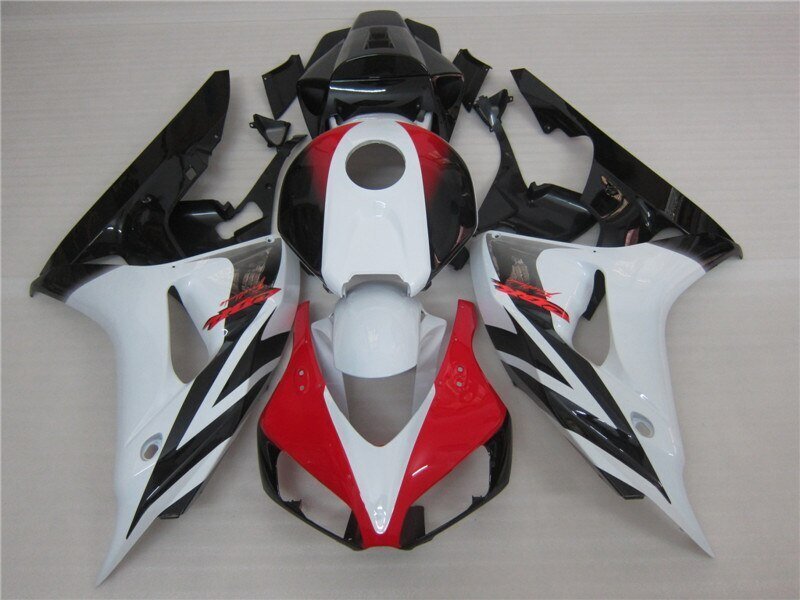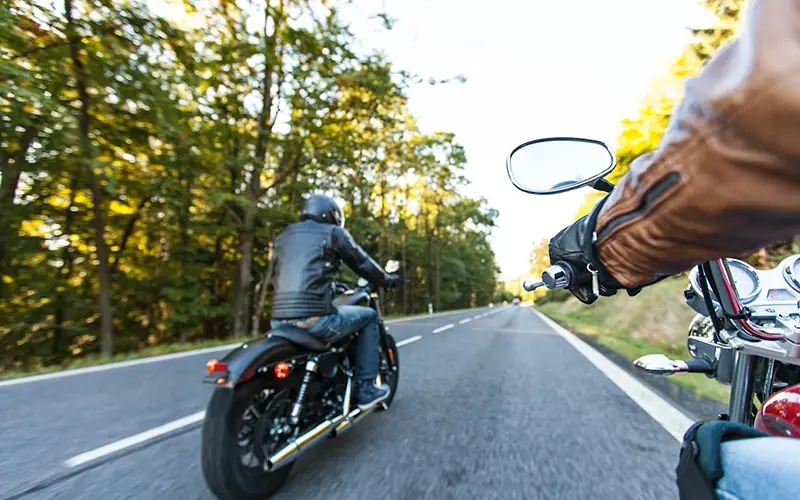Motorcycle Fairings protect the rider and the bike from the elements. They serve a number of functions, the most prominent of which is to boost the motorcycle’s efficiency and speed. This article will explain what fairings are, how they function, why you should consider installing them on your bike, and the process of installation. We’ll also tell you what to look for in motorcycle fairings.
Motorcycles with fairings give the impression that the bike has its own wings. They shield the bike’s front and sides from the elements, and some fairings even go around the back and over the seat. They aren’t there just for show, though; they increase aerodynamics by decreasing wind resistance on long journeys (or in races!) Additionally, fairings shield you from flying debris and insects at high speeds.
Riders of the earliest motorcycles had to deal with the full force of the wind and the occasional bug in the face because there was no bodywork to the frame. These days, you can pick from a wide variety of motorcycle fairing designs and materials to suit your own taste and riding style.
What Exactly Are Motorcycle Fairings?
To protect the rider and the bike itself, fairings are a must-have. The fairings not only add to the bike’s visual appeal but also boost performance and shield the rider from the elements. Sadly, few bikers are familiar with the term “fairings.”
To begin, the word “motorcycle fairings kit” can refer to a variety of different products. Motorcycle fairings, fairing kits, motorcycle plastics, a pair of fairings, and similar terms can come up in conversation.
Some motorcycles have a huge, wing-shaped panel or cowl over the front wheel, between the handlebars and the frame, and just below the front tire. The fairing may or may not include a windshield, and if it does, the windshield’s size and form can also be quite questionable.
While speakers and hidden storage compartments are two of the main draws for fairings, there’s a lot more to them than meets the eye. The rider’s safety is the primary focus of most fairing designs.
Motorcycle Fairings Kit:
Second, it’s important to note that motorcycle fairings are quite popular items for sale as whole fairing kits and as individual fairing components. Motorcycle fairing kits consist mostly of the following fairing components:
- Fairing for the Nose and Front Headlights.
- Splash Guard / Front Tire Fender.
- Side Fairings (Left and Right).
- Tank Protective Cover.
- Seat Cowl and Rear Fairing.
However, personalized dual sports helmets are a must-have for those who value a “matching moment” with their sports bike.
What Material Are Motorcycle Fairings Made Of?
Now that we know what motorcycle fairings are and why they’re there let’s go through the typical components that go into making them.
- Acrylonitrile butadiene styrene (ABS) is a lightweight plastic that is also strong, flexible, and durable. Producing fairings for sports bikes is its primary use. ABS is used by most aftermarket fairing producers as well because of the material’s remarkable properties, which include the rigidity and strength of styrene and acrylonitrile, as well as the resilience of polybutadiene rubber. The anti-scratch and anti-impact properties of ABS make it a popular choice. In addition, the primary motivation for developing anti-lock brake systems (ABS) was to provide the rider with the highest level of safety possible in the event of an accident.
- Fiberglass is a substance consisting of woven fibers that are widely popular as a reinforcing agent for a wide variety of polymer goods. This material is commonly used for the fairings of racing motorcycles. Generally speaking, fiberglass outperforms ABS plastic in terms of durability and weight. If your fiberglass fairings ever become scratched up, you may fix them by adding new layers of woven fiberglass fabric mixed with a polymer like epoxy over the damaged area, then sanding and finishing it.
- The most costly and lightest material for motorcycle fairings is carbon fiber reinforced polymer. Most commonly found on sports bikes and in motorcycle racing, as well as on riders who want to make a statement, carbon fiber motorcycle fairing kits are lightweight, strong, and durable.
Different Types of Motorcycle fairings
How often do you go for a fast ride on your bike? Or perhaps you’re a racer? Both new and old motorcycles benefit from having fairings added or updated.
To cut down on wind resistance, these frames were common for use on sports and racing bicycles. There is a wide variety of fairings for motorcycles. They often go at the front, although some can also go on the sides. There will be a certain method for installing them that you must follow depending on where you choose to put them. The sort of motorcycle you have is also a consideration throughout the installation procedure.
Let’s have a look at the several motorbike fairings available.
Dolphin Motorcycle Fairing
Large dustbin fairings are used to cover the front of motorcycles. This is a sleeker, more modern, and more compact variant with a larger windscreen. In profile, it looks like a dolphin, which is why it’s so popular.
Full Motorcycle Fairings
A racer really needs complete fairings since they shield the entire bike from damage. A windscreen is included as well.
Half Motorcycle Fairings
The lower parts of the motorcycle, including the handlebars and engine, are protected by half fairings. In many cases, they can be expanded into complete fairings.
Quarter Fairings
These are minimal, consisting only of a windshield and some shielding for the headlamp. Possibly sufficient if your only transgression is excessive bicycle speed.
The Advantages of Fairings
Here are some of the key reasons why need to invest in fairings too, along with other motorcycle parts and accessories.
Higher Efficiency
Because of the significant performance boost it provides, the fairing is quite common on sports and racing bikes. The bike gains speed thanks to its improved aerodynamics. This is crucial because it allows riders to increase their speed and so get an advantage in races. That’s a huge plus in any kind of racing, but especially in more extreme climates.
The bike’s steadiness increases as it is protected from the wind. This is especially useful in racing situations since it lessens the likelihood of accidents due to instability.
Comfort
Fairing provides a more pleasurable and relaxing ride by cutting down on wind resistance. There is less wind noise coming from your helmet and less wind resistance on the bike and rider as a whole. This comes in handy for everything from risky riding in severe winds to high-speed competitions. Deflecting the chilly air makes a huge impact in frigid weather, saving you from being uncomfortable and even uncomfortable for the duration of your trip.
A more upright position is achieved by the use of fairing, which can also increase comfort. Custom fairing allows you to find the ideal position for your legs.
Customizable
The fairing of a motorcycle is a large, unadorned surface, perfect for those who enjoy personalizing their ride. Custom graphics and images for motorcycle fairings can be ordered from a variety of sources. You can give your bike more distinction and individuality with this.
With bespoke fairing, you can design your ideal bike down to the last detail.
Protection
A motorcycle’s engine and internal components are better protected by a fairing. The fairing of a motorcycle is there to protect the rider and the bike’s vital components, especially in the case of an accident.
Time of Engine Use
The increased efficiency of the vehicle’s aerodynamics reduces the strain on the vehicle’s power plant. It simply increases the product’s durability and efficiency. For individuals on a tight budget who wish to avoid the high expense of replacing a worn-out engine, regular engine maintenance is a must.
Accessories
Many bikers now opt to install navigation systems, cell phones, and other devices in their cockpits. These capabilities have rapidly become standard for tasks as varied as tracking performance and navigating unfamiliar terrain.
These components may have difficulty operating without proper front fairing on the motorcycle. The fairing protects the rider’s electronics while yet allowing for easy access.
Aesthetics
The aesthetic value of a motorcycle can be greatly increased by installing a fairing. It has the ability to improve the bike’s looks and monetary worth.
Refinishing the fairing of an old motorbike has the ability to make it appear new in an instant.
How To Install Or Replace A Fairing Kit
Next, you find the general rule of thumb for all motorcycle types.
In this guide, we will go through the basics of putting your motorbike fairings on. Without knowing more about your motorbike and your skill level, it can only provide you with extremely broad and generic instructions for installing the parts.
Step 1: Buy a Personalized Aftermarket Motorcycle Fairing Kit
Your motorbike will need new fairings, and you should start by ordering or buying them. You have the option of either shopping online or placing a special order for custom-made fairings. Your motorbike can easily and quickly have a sleeker appearance thanks to the fairings that cover the front, sides, and exhaust pipe. If you want to find motorcycle fairings, your best bet is to contact the motorbike’s OEM or hunt out the OEM number for the fairings you’re interested in.
Step 2: Locate the Connection Points for the Fairings
When ordering motorcycle fairings straight from the factory, you should have no trouble finding the correct fittings to secure the fairings to your bike. Fairings that aren’t factory originals or bespoke creations will need to have their mounting hardware matched up with the bike. Before beginning the installation procedure, you must choose where and how to attach the fairing.
Step 3: Attaching the Fairing to Your Motorcycle
Using a ratchet and/or screwdriver, secure the fairing to the motorbike once you’ve discovered its attachment point. As you tighten the bolt, double-check that the fairing is correctly attached to the motorcycle. After you have tightened the fastening, you can ride your motorbike and flaunt its new personalized design.
Contact the fairing’s designer right away if you’re having trouble putting a custom-built, non-factory-made fairing (i.e., an aftermarket buy) on your motorbike.
Process for a Full Fairing Set
In most cases, a complete set will have all of the features found in individual fairings. To do this task, you will need to use an electric drill in conjunction with the equipment found in the fairing toolset. You can follow the instructions, or skip any steps that may not apply since they are not a part of your kit. Place all of the equipment in this bag:
Step 1: Install the Tail Section Fairing
You can install this precisely where the bike’s back seat would normally go. The fairing’s mount points act as a starting point for drilling pilot holes. Next, you’ll need to attach it using the included fairing toolset, which you can do by moving the device behind the seat.
Step 2: Replace the Front Fender
This fits over the top of the tire on the front wheel and gear. In order to determine where on the fairing to drill holes, you must first locate the holes in the bike.
Step 3: Install the Tank Cover
This one protects the tank or the area in front of your seat. You’ll need to be careful because the mount points are only in the four corners.
Step 4: Complete the Front Fairing
Here we reach the section that encompasses the headlight region and the top front body. Don’t screw things up just yet; you can drill the holes later if you like. Instead, you can use clips to firmly fasten the fairing into place.
Step 5: Take The Bottom Cover
You’ll need to do your own hole-making when you take this. Before you begin drilling, take note of the hole locations on both the fairing and the front piece. This will ensure that the process goes smoothly and quickly. Hopefully, you can understand why we didn’t prioritize finishing the front fairing repairs. The carefulness of this order is crucial.
Step 6: Simply Repair Everything Else
The rear hugger fits in front of the back wheel, and other available options include swing arm covers, heat shield slides, and air dust covers. They’re little pieces that may be attached using your chosen method and sequence. Now that most of the work has come to an end; setting things up won’t take long at all.
Which Motorcycle Fairings Are Best for Me?
The sort of motorbike you ride and your personal tastes are important factors to consider when selecting fairings. You’ll need to determine which of the many possible designs and materials is ideal for your purposes.
Motorcycle fairings serve several functions and are an integral element of your bike. Exactly like your motorcycle parts and accessories. They shield you from the elements and make your bike more aerodynamic. In doing so, you can improve your riding performance and safety. Moreover, fairings make your motorbike seem unique and express your individuality.
Plastic, fiberglass, and composite are just some of the options for crafting your fairing. There are good points and bad ones to every option. For instance, plastic is inexpensive but flimsy, while composites are more costly but resistant to water damage (although heavier). Fiberglass is quite common as a compromise material since it satisfies both the need for long-lastingness and the need for a low cost.
Consider your riding style while picking your motorbike fairings. A simple plastic set of fairings should do for short journeys around town. However, something more sturdy and aerodynamic is a must for long-distance touring or racing.
There is a set of fairings out there that is ideal for you and your motorbike. To that end, it’s advisable to look around until you locate a suitable set. You won’t regret it at all!
What Factors Should You Consider While Selecting A Set Of Motorcycle Fairings?
Some things to bear in mind are as follows.
The model of motorcycle you own can affect the type of fairing you need; not all fairings are created equal and some may require modifications to fit your bike. Before purchasing a fairing, it’s important to find out if it’s compatible with the model of your motorcycle.
How often you ride on the highway; will help you decide if wind-deflecting fairings are worth the investment. You may want to consider something that shields you from insects and road debris if you frequently ride in the city.
Budget; as with anything else, is an important factor to consider when shopping for motorcycle fairings. Make sure you budget enough to buy the correct fairings for your purposes.
Your taste; what do you prefer? While some riders like their fairings to be specifically custom-made for them, others may opt to save money by purchasing fairings from an internet retailer or local dealership. If you want to save money, you can also buy secondhand motorbike components.
You now know what to look for in motorbike fairings and can go out and make your purchase. You can surely take your time browsing the various options to discover the perfect set for you… which matches your dual sports helmets. Investing in a high-quality set is worthwhile because they boost your bike’s aesthetics and functionality. A fantastic pair of motorbike fairings will greatly enhance your riding experience.
To Sum Up
There is a fairing designed to fit your motorcycle and your riding style. Fairings not only give your bike a more streamlined look, but they also increase your level of safety on the road.












